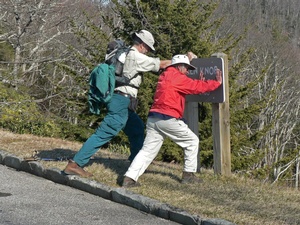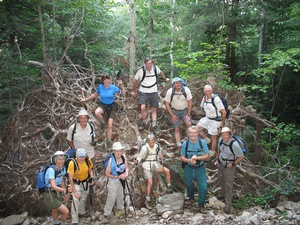Carolina Mountain Club Hike Leader Guidelines
 Hiking is a healthful, social and pleasant activity, and hikers enjoy meeting and conversing with their fellow hikers. Hike leaders will enjoy the opportunity to interact with the other hikers and to lead an activity where everyone is up-beat, friendly and enjoying their day in the woods. These guidelines will help the hike leader to make the hike a successful experience for all.
Hiking is a healthful, social and pleasant activity, and hikers enjoy meeting and conversing with their fellow hikers. Hike leaders will enjoy the opportunity to interact with the other hikers and to lead an activity where everyone is up-beat, friendly and enjoying their day in the woods. These guidelines will help the hike leader to make the hike a successful experience for all.
Preparing Hike Description
1. A hike description must be prepared for Let’s Go. This description will usually be prepared by the hike scheduler, with the assistance of the hike leader. Information sources are the hike database, previous hike sign-up sheets, the hike leader, and/or the hike scheduler. The hike description will include:
- Text describing hike
- Hike length
- Cumulative hike ascent
- GPS information, if available
- Type of hike (in & out, loop, car shuttle or key swap)
- Driving distance
- A requirement for reservations if the number of hikers is to be limited (NOTE: Wilderness areas are limited to 10 hikers);
- Starting time and meeting place. NOTE: CMC guidelines require hikes to end one hour before sunset (all-day hikes) or 30 minutes before sunset (half-day hikes)
- List second meeting place and meeting time, if to be used
2. The Hike scheduler will prepare the text and send it to the hike Leader for proof-reading and approval.
Month Before the Hike
1. Scout the hike, preferably within one month of the hike, to verify:
- Trail accessibility and condition
- Adequate parking at trailhead
- A desirable lunch or snack stop
- Points of interest along the trail
- Hiking time
 2. If the scout results in changes to the hike or if the leader wants to communicate additional information about the hike, the leader can post the information as a scout report. This will be put in the hiking schedule on the website. This could also be an opportunity to promote the hike with more text than Let's Go descriptions allow. A picture could be included as well.
2. If the scout results in changes to the hike or if the leader wants to communicate additional information about the hike, the leader can post the information as a scout report. This will be put in the hiking schedule on the website. This could also be an opportunity to promote the hike with more text than Let's Go descriptions allow. A picture could be included as well.
3. Obtain permission to park and/or hike across private property, if required;
4. Answer phone calls and e-mails concerning questions about the hike;
5. Make a reservation list for any hike with an attendance limit.
6. Although not a requirement, preparation of a hike map for distribution to hikers (especially for complicated routes) is always appreciated by the hikers.
7. Last but not least, make a copy of the Incident Report Form found under hiking in the member website and carry it in your backpack. The form should be completed in case of an injury which results in an intervention from a medical source or some type of property damage. A copy of the completed form should be mailed to the club President and the original to the hike scheduler.
Day of Hike (before hike)
 1. As hike leader, you have the right and obligation to:
1. As hike leader, you have the right and obligation to:
- Limit the number of hikers, if necessary;
- Exclude those who, in the opinion of the leader, are not physically capable or experienced, or not properly clothed and equipped for the hike. Especially take note of footwear on new hikers;
- Change the hike from the printed description if trail conditions have changed, particularly if hiker safety will be jeopardized. Avoid changing the difficulty of the hike significantly. If the hike has changed, be very clear, at the meeting places, what the changes are.
2. Assume full charge and responsibility for the trip. Appoint a sweep who is a strong hiker and who will accept responsibility for checking the hiker count and assuring that no one is lost.
3. Take a simple first aid kit. Both the leader and sweep should carry whistles for communication. Optionally, a cell phone can also be taken, although reception is sometimes poor in the mountains. For cold weather hiking, carry extra food rations, a space blanket, light source and matches.
4. Meet the hikers at the primary meeting place or, if meeting them at a secondary place, ask those going to the primary site to contact you by email of phone prior to the hike. If the hike is canceled make sure you post the cancelation on Breaking News.
5. At the meeting places ask: a) Is anyone allergic to anything, particularly bee stings?; b) Does anyone have a health or medical condition that could be influenced by this hike?; c) Are there any conditions that could cause the hiker to slow down significantly?; d) Does everyone have any medications that they could possibly need on the hike? e) When was the last time that you went on a x mile hike? (and follow up with questions to determine fitness).
6. Have all hikers sign the sign-in sheet, and do a head-count - Hike Sign-up Sheet
7. Hike leaders should remember that hikes are social occasions and should take an opportunity at the beginning for everyone to introduce themselves if new hikers are present. Hikers new to the group should be educated as to proper hike etiquette and each hiker’s responsibility to the group (being mindful of the hiker behind as well as the one in front).
8. Arrange car pooling and verify that everyone has a ride.
9. Before leaving, explain the driving route to each driver and count the number of cars. For complicated routes, it is helpful to prepare a map for drivers.
10. When driving to the trailhead, drive at a speed that enables the following cars to keep up. When making a turn, assure that all cars have made the turn.
Day of Hike (during hike)
1. The hiking pace should be controlled by the leader to keep all hikers within reasonable distance behind the leader. Occasionally, check that the sweep is visible to assure that the group stays together.
2. Hikers must not go ahead of the leader or behind the sweep except by specific permission of the leader/sweep.
3. The hike leader should stop at prudent intervals for:
- Trail breaks
- Rest and water stops
- "Catch-up" stops to assure that slower hikers catch up with the rest of the hike, and to allow them resting time if needed (NOTE: Beginning hikers especially get frustrated by a leader who hikes way ahead, then waits for everyone to catch up, and then starts hiking as soon as the last hiker shows up, without allowing the last hiker to rest)
- Snack and lunch stops
4. The hike leader must stop at all trail intersections, junctions or any place where there might be confusion, and assure that all hikers see the correct direction of travel. This usually requires that the leader wait until the sweep is visible.
5. If the time needed to complete the hike would be later than the minimum “ending-time-before-sunset” time, the hike leader must stop the hike and return to the trailhead.
Day of Hike (End of Hike)
1. The leader should give non-members a CMC application form and encourage them to join the club.
2. Encourage a photographer to email a picture to the leader if the leader has not made one himself.
3. If there is no map and GPS track of the hike on the website, encourage a hiker with a GPS to send the track to the Hiking Webmaster.
4. The leader must not leave the trailhead until all hikers are present and all car engines have been started.
5 .If necessary (use personal judgment), lead the other drivers back to familiar roads.
After the Hike
1. Prepare a short description of the hike and post the report on the website.
2. Fill in the requested data on the back of the CMC Sign-in Sheet and mail it to the hike scheduler at the address listed. Your information and suggestions will be very helpful for the next time the same hike is scheduled.
Conclusion
 Carolina Mountain Club thanks you for leading a hike for the club.
Carolina Mountain Club thanks you for leading a hike for the club.
We hope you have enjoyed the experience and that you would like to lead another hike for us in the future!